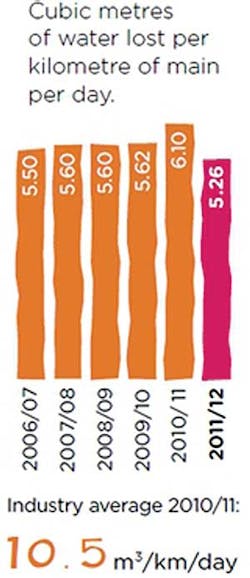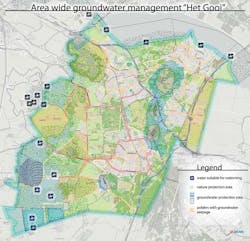Integrated Leakage and Pressure Management System
Utility Anglian Water was spending the equivalent of £13.4 million to fix 27,000 leaks each year. Manuel Parra discusses how implementing an integrated leakage and pressure management system has helped the water provider improve its overall service.
Anglian Water is the largest water and wastewater company in England by territory, supplying services to 4.3 million customers in a region stretching from the Humber in the north to the Thames in the south, from Northampton in the west across to the east coast. The company also provides water services to the Hartlepool area as Hartlepool Water. Anglian Water's water supply network has an extension of nearly 23600 miles of pipelines, divided in approximately 1.700 District Metered Areas.
Schneider Electric is currently implementing the Integrated Leakage and Pressure Management System (ILPMS) for the UK Company Anglian Water Services. The key features of the ILPMS are leakage calculation, network performance analysis, leakage detection management, repair monitoring, pressure management, business intelligence and regulatory reporting.
The project includes the bi-directional integration of the ILPMS with virtually all other corporate systems such as telemetry, different ERP modules (asset management, work management, billing and customer relation, and finance), GIS, and hydraulic models.
This is a clear example of Smart Water Network implementation in a very complex information technology environment. Such an ambitious project is not motivated by poor leak management results: with a leakage rate 30% below the UK industry average and a leakage level of 5.26 m3/km/day, Anglian Water is a frontier performer in water loss management.
The utility decided to replace the existing District Metering System (DMS) that was becoming end of life and a series of spreadsheets/databases which are currently used as the basis for leakage performance reporting to better support the company's massive effort in this area: about 300 staff working every day to find and fix around 27,000 leaks every year and USD21 million spent targeting this work during the last year.
The ILPMS project started in July 2012 and will finish in December 2013. The expected benefits of the ILPMS are multiple. From a broad perspective it will help Anglian Water to maintain the position as leader on leakage control and water resource protection by reducing resource losses and operational costs, enhance customer service and environmental stewardship and making regulatory compliance easier. From a technology perspective these solutions will reduce the cost of ownership due to the outsourced support and maintenance throughout the life of the system and guarantee Anglian Water on acquiring a constantly evolving product.
A smart water network approach
Smart Water Network solutions use data and systems integration features to help utilities optimise costs, improve operations and make better business decisions. They give new life to existing investments in assets and technology and contribute to the achievement of the company's strategies by using the large amount of operational and business data utilities are already generating.
These solutions decipher this data and turn it into valuable information for decision support throughout the different departments, allowing the utility to identify efficiency improvement opportunities that will create operational cost reductions, better capital expenditure planning and improved management and service.
A well thought out Smart Water Network approach can accelerate the implementation of the utility's overall strategy. In other words, the Smart Water Network is a concept that should be put to use in the solution of real business needs. Anglian Water Services exemplifies how the use of all this data and information should be used to help the company achieve its ultimate goals.
This gathering of information aids in targeting preventive maintenance, improved condition assessment policies, real time leak detection and even crisis management. Utilities can pinpoint exactly where there is a problem in real-time, creating a customer service system that is proactive and responsive. Now, utilities can inform customers of the problem and have it fixed before it is reported.
In other words, they have information not only for reporting, but for taking actions. This makes it easier for utilities to see where its challenges lie, pinpointing a certain part, section or system of the utility that is faulty. In turn, this also shows utilities where it needs to invest or if a small maintenance job can solve problems that may be affecting business. Linking this data is a direct return on investment, allowing utilities to see where they are losing money and where its largest gains take place. These “best practices" can then be duplicated throughout the system.
shared data = smarter decisions
Having data silos is like paying for premium cable TV and watching only one channel. It is a waste of time and money. However, sharing this data throughout the company generates the opposite effect. It means that decisions no longer have to be made in one centralized location of the utility, making for a more streamlined process in all areas, including out in the field.
This is due to data that can quickly be turned into valuable information for decision making in all the areas of the company, alleviating an entire part of the utility's information sharing process that is normal for everyday operations. Now operators, planners and managers can receive constant, relevant and accurate updates anytime from anywhere without having to wait for offline reports or information.
Real-time data also makes sense beyond the traditional control room. For example, online modeling operational systems use this data to help utilities to forecast the impact of a pollutant in the network, thus shortening the times to react to such types of events, or understand the effect that a repair has on the whole network, minimizing the impact on the customer's side.
Another useful feature of real-time data is the ability to maintain up to date information in the utility, so when field crews are deployed to perform some work in, they have the latest data in their field devices, helping them fix the problem sooner, and more accurately, creating operational efficiency.
Water challenges vary from company to company, and strategies will differ depending on these challenges, but many utilities have already found that implementing smart IT solutions can help them achieve their goals while maintaining the quality standards that their customers deserve.
Author's note: Manuel Parra is Schneider Electric's water competency center director. He is a co-founder of the Smart Water Networks Forum (SWAN) and a member of its Board.


